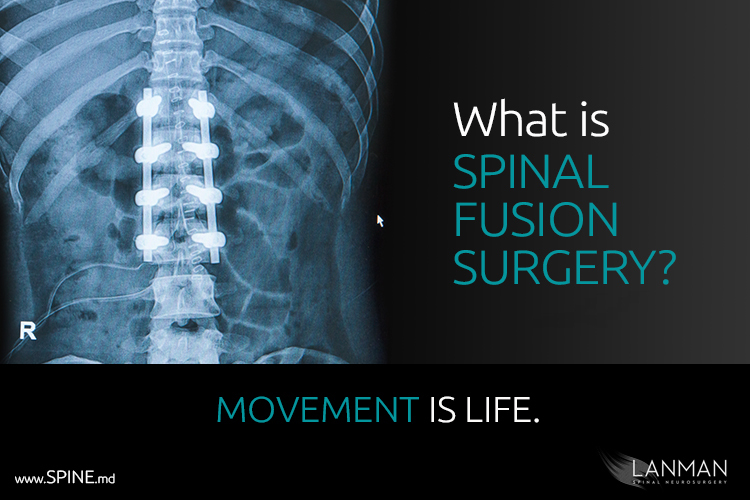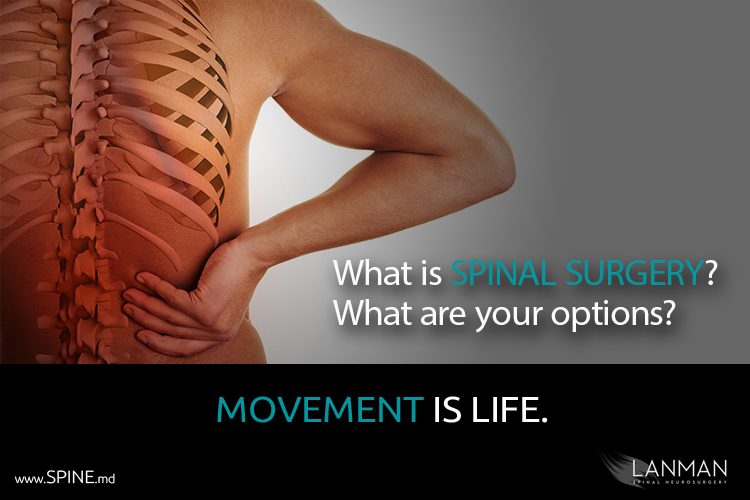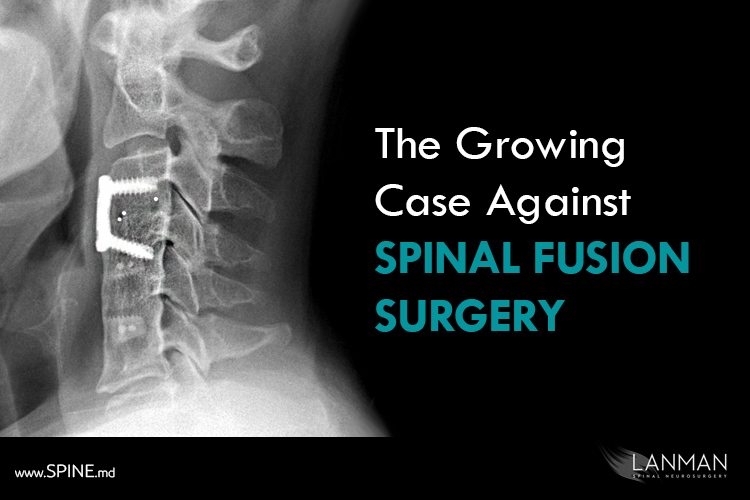Over the last three decades, Dr. Todd Lanman has established himself as the leading spinal neurosurgeon in Los Angeles. Dr. Lanman completed his residency in Neurological Surgery at University of California at Los Angeles (UCLA) in 1989. He is board-certified in neurological surgery and fellowship-trained in spine surgery. He has been a pioneer of artificial disc replacement surgery and has performed scores of spinal fusion surgeries over his career. If you are considering spinal fusion surgery in LA, schedule a consultation with Dr. Todd Lanman.
What is a Spinal Fusion?
A spinal fusion is a spine surgery procedure in which a diseased or damaged spinal disc (i.e., intervertebral disc) is removed, and bone-like material is put in its place. The two spinal bones and the artificial bone between them are held together with instrumentation such as screws and plates. Over time, the spinal bones fuse together. Removing the natural spinal disc relieves pain, and once healed, the fused spinal bones provide strength and support.
Types of Spinal Fusion Surgeries
At least half a dozen lumbar spinal fusion surgeries are in use today including:
Anterior Lumbar Interbody Fusion (ALIF)
Posterior Lumbar Interbody Fusion (PLIF)
Posterior Gutter Fusion
Transforaminal Lumbar Interbody Fusion (TLIF)
Extreme Lateral Interbody Fusion (XLIF), and
Anterior/Posterior Spinal Fusion.
Anterior means the surgeon approaches from the front of the patient’s body and posterior means the surgeon approaches from the patient’s back. Lateral means the surgeon approaches the spine from the patient’s side, but the incision is still made in the patient’s back. Transforaminal also indicates that the surgeon makes an incision in the patient’s back since the surgeon works across (trans) the spinal foramen (foramina), which can be most easily accessed from the back or side of the spine.
Cervical spinal fusion is divided into two main types: anterior cervical fusion and posterior cervical fusion. The most commonly performed cervical spinal fusion goes by the acronym ACDF, which stands for Anterior Cervical Discectomy and Fusion.
What are the Benefits of a Complete Spinal Fusion?
The primary benefit of spine fusion is that the surgical procedure can relieve neck or low back pain and other symptoms caused by a diseased disc. A diseased intervertebral disc can press on spinal nerves and/or the spinal cord, causing severe pain, unpleasant sensations, numbness, and muscle weakness. During spinal fusion surgery, the damaged disc is completely removed and areas of arthritic or otherwise abnormal bone (e.g., bone spurs) are removed. Removing problematic disc and bone often relieves symptoms. Bone-like material placed between the two spinal bones creates necessary separation between the spinal bones. Once fused, the two bones and the bone-like material in between them form a solid unit, providing strength and support for the spine at that level. Notably, the two fused spinal bones no longer move relative to one another, which can limit the overall mobility of the spine.
About the Procedure
Spine fusion surgery differs slightly depending on whether the disc will be fused in the cervical spine (i.e., neck) or the lumbar spine (i.e., lower back). In cervical spine fusion, the spine surgeon usually makes a small incision in the front of the neck, off to one side. For lumbar spinal surgery, the spine surgeon may choose an anterior or posterior approach, which means making a small incision in the lower abdomen or along the spine, respectively.
In both cervical and lumbar spinal fusion surgeries, organs and other structures are carefully moved and the diseased disc is cleared and exposed. The spine surgeon carefully removes all parts of the spinal disc, including any pieces that may have migrated outside of the normal disc space. Once the disc is completely removed, a small bit of bone-like material (e.g., artificial bone matrix) is placed in the space that remains, often inside of a cage. The two spinal bones are held in place with instrumentation such as plates, rods, and screws, which holds the bones in place as the bones and bone-like material fuse over the following weeks and months.
How Long Does a Spinal Fusion Surgery Take?
Surgical times vary, but most spinal fusion surgeries are performed within three to six hours. Spinal fusion surgery is performed under general anesthesia, so plan on additional time to recover from the anesthesia.
Spinal Fusion Surgery Patient Recovery and Future Outlook
Complete recovery from spine fusion can take up to six months. However, most people recover at least partially long before that time.
Spinal fusion surgery may be performed as an inpatient, outpatient, or in an ambulatory setting. Inpatient spinal fusion surgery requires at least one night in the hospital, outpatient spinal fusion surgery means the patient is discharged between 8 and 24 hours after surgery, and ambulatory means the patient is discharged within 8 hours after spinal fusion surgery. Patients who meet certain criteria can safely have outpatient or even ambulatory spinal fusion surgery.1
Soon after surgery, you will be asked to “ambulate” which means being able to stand, walk around, and sit down safely and effectively. Once you can ambulate (or swallow, in the case of cervical spinal fusion surgery), you can usually be discharged home under the care or a friend or family member.
You will likely need opioid medications for a short while after spinal fusion surgery. When possible—usually within a few days—you will transition from opioids to NSAIDs or acetaminophen.
You will not be able to drive, lift anything greater than 5-10 pounds, or perform any real exercise other than walking for the first two weeks after surgery. Some of your activities like work duties will continue to be restricted for several weeks after the procedure. After 4 to 6 weeks, you should be able to start physical therapy to help strengthen your muscles and regain flexibility. Your spine surgeon will likely order a spine X-ray at 3 months after spinal fusion surgery to make sure that the bones and bone-like materials are fusing together as they should.
Most patients enjoy pain and symptom relief after spinal fusion surgery. It is important to realize that spinal fusion surgery—especially multi-level fusion—will rob the spinal column of some flexibility and mobility. That said, quality of life after spinal fusion surgery is quite high, particularly for those who are well-prepared for surgery and follow recovery instructions closely.
What to Expect from Your First Spinal Fusion Follow Up Appointment with Dr. Lanman in Los Angeles
Your first spinal fusion follow-up appointment will take place with Dr. Lanman in his Beverly Hills office in Los Angeles, at the corner of North Roxbury Drive and Santa Monica Boulevard. You will meet with Dr. Lanman in his third-floor offices. During this appointment, he will ask how you have been feeling and recovering, examine your surgical incision, and see if you are having any residual symptoms. If any sutures or staples were placed in the skin during the spinal fusion procedure, they will be removed during this follow-up visit, right in Dr. Lanman’s Los Angeles office (i.e., not a surgical procedure). This first follow-up appointment is an excellent time to ask Dr. Lanman about the activities you can and cannot do, depending on how well you are healing. If the wound has completely healed, for example, Dr. Lanman will probably allow you to resume certain activities such as taking baths and swimming.
Conclusion
If you are suffering from chronic neck or low back pain in Los Angeles, CA, schedule an appointment to see Dr. Todd Lanman, perhaps the top spinal neurosurgeons in Southern California. You may be a candidate for artificial disc replacement, a procedure which Dr. Lanman has pioneered and perfected. If not, you may need spinal fusion surgery. Again, Dr. Lanman is one of the top spinal fusion surgeons in LA and surrounding areas. If you are considering spinal fusion surgery and live in the LA area, make an appointment to see Dr. Lanman today.







